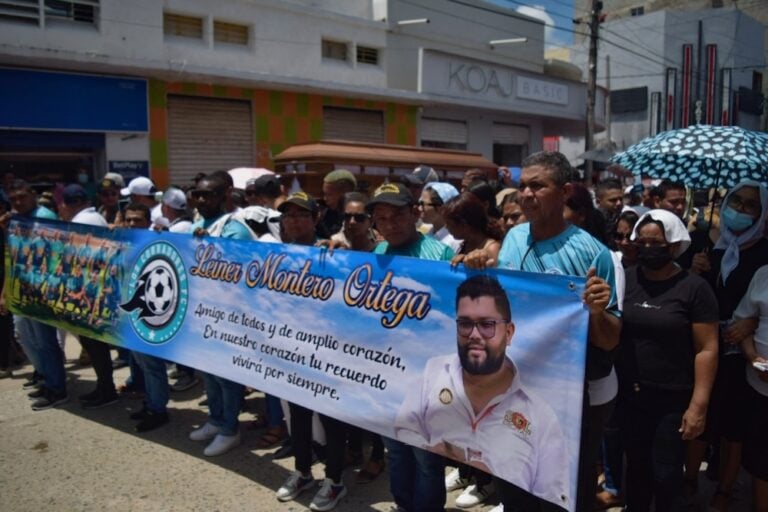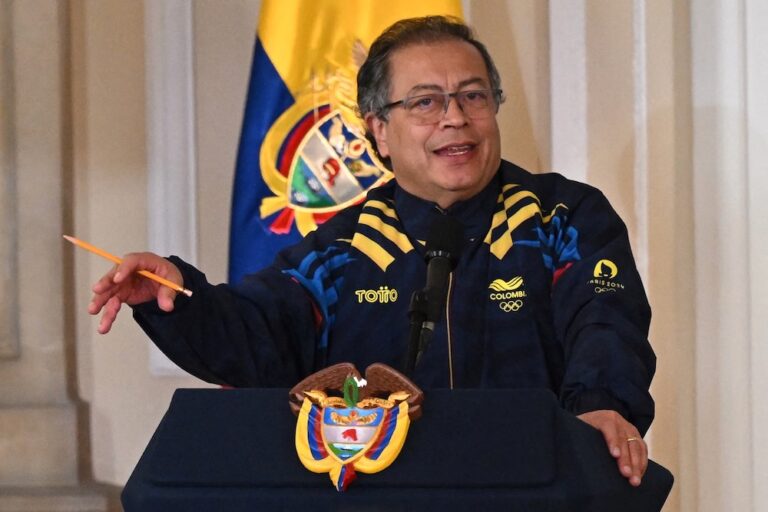(RSF/IFEX) – The following is a 6 September 2005 joint capsule report by RSF, FLIP, IPYS, IFJ and CPJ: Fear kills off the news in the Valle del Cauca Reporters Without Borders and four other press freedom groups went on a joint fact-finding commission to investigate two years of attacks on press freedom in the […]
(RSF/IFEX) – The following is a 6 September 2005 joint capsule report by RSF, FLIP, IPYS, IFJ and CPJ:
Fear kills off the news in the Valle del Cauca
Reporters Without Borders and four other press freedom groups went on a joint fact-finding commission to investigate two years of attacks on press freedom in the Valle del Cauca province of southeastern Colombia from 13 to 16 July 2005.
Helped by the United Nations, the five organisations — the Colombian Fundación para la libertad de prensa (FLIP), Peru’s Instituto prensa y sociedad (IPYS), the International Federation of Journalists (IFJ), the US Committee to Protect Journalists (CPJ), as well as Reporters Without Borders – met with journalists, local authorities and community groups in the province’s five towns and cities (the capital Cali, Buenaventura, Tuluá, Cartago and Palmira).
The murder of two journalists in the space of a few months in 2004 and then threats to at least four others showed how vulnerable the region’s media workers are. The right to be informed has been undermined and little news has appeared in local media about the situation in Valle del Cauca, even though armed groups are fiercely fighting each other there and the area is plagued by violence linked to drug trafficking.
Two of the country’s most powerful drug cartels are based in the northern Valle del Cauca, where they have formed two rival private armies, the Machos and the Rastrojos. Also present are the far-left guerrillas, the Revolutionary Armed Forces of Colombia (FARC) and the National Liberation Army (ELN), who are fighting for control of the area against their common enemy, the far-right paramilitary United Self-Defence Groups of Colombia (AUC), whose forces are still active there despite the start of demobilisation at national level.
In Buenaventura alone, the local police chief said about 30 people were being killed each month. The weekend before the joint mission arrived, seven inhabitants in the port neighbourhood of Lleras, from which drug cargoes routinely leave in speedboats, were killed by men in uniform. Near Cartago, three groups of FARC guerrillas are fighting the drug cartels. Some neighbourhoods of Cali are ruled by armed gangs.
A media stifled by killings and threats
Journalists are among the victims of this violence. The murder in Buenaventura of William Soto Cheng, presenter of the TV programme “Litoral Pacífico”, on 23 December 2003, was followed on 4 February 2004 by that of news presenter Oscar Polanco Herrera, shot dead as he left the premises of the Cartago TV station CNC. Threats increased in Buenaventura to those who tried to report what was happening in the town. Patricia Gutiérrez, local correspondent of the national daily El Tiempo, was forced to flee the region, soon followed by cameraman Fanor Zúñiga Hurtado. The fact-finding mission identified four groups at the heart of these attacks and threats against journalists – drugs traffickers, paramilitaries, guerrillas and local politicians.
Local authorities cannot be touched
Most of Soto Cheng’s colleagues believe he was killed because he exposed fraud during the Buenaventura town council elections, accusing the army and police of helping to rig the vote, before withdrawing the accusations under threat of legal action. The bodyguard of an aide of new mayor Saulo Quiñones was suspected of involvement in the killing and arrested, but freed a few weeks later. Quiñones said local journalists were being threatened by “illegal armed groups” (guerrillas and paramilitaries) and not by politicians.
But all the local media says administrative corruption is one thing journalists avoid reporting so as not to put their lives in danger. Journalists in Cartago are even more cautious about local politicians, some of whom are thought to have direct links with the northern Valle cartel. To avoid problems, nobody investigates or writes about this. Some journalists said they received threats after criticising the circumstances of the building of a town bus-station.
Some journalists in Tuluá do not investigate police corruption to avoid trouble for themselves and note that despite its clear existence, it is not mentioned in the media. “If I hear of a case, I prefer to turn a blind eye and just report the police statement,” said one TV journalist.
The situation is easier in Cali and Palmira, where local government abuses are investigated, but journalists still pay a price. The daily paper El Caleño set up an in-depth reporting unit in August 2004 and exposed several local corruption cases, but the unit’s chief, Blanca Torres, has been threatened a few times. Eight men went to her home on 18 December 2004 while she was absent and ransacked it without taking anything. Employees of the Palmira station Radio Luna, which is critical of the mayor, have received e-mail threats in 2005 and one of them got a threatening phone call.
Town governments, as the main source of vital advertising revenue for the media, also routinely use economic blackmail. Say nice things about the town hall and you’ll get the ads, journalists say. It is an extra weapon local authorities have to silence the media.
Drug-trafficking: a taboo subject
Several areas of Valle del Cauca province are hubs or centres of drug-trafficking, but the local media very rarely mentions this because it is too dangerous.
Cartago includes the remote area of the Cañon de Garrapatas, where coca grows on 20,000 hectares of land. The armed group Los Machos, run by locally-born Diego Montoya Henao, one of the world’s most-wanted drug-traffickers, is fighting another called Los Rastrojos, each of them with between 500 and 800 troops.
Oscar Polanco Herrera, of the TV station CNC, is thought to have been killed by these drug-traffickers. A clear link with his journalistic work has not yet been established, but his murder was enough to silence his colleagues, who all say drug-trafficking is an off-limits subject in Cartago.
The fact-finding mission also noted that the 14 July arrest (which occurred while the mission was in the country) of José Aldemar Rondón, one of the leading money-launderers of the local cartels, was a national news item and also reported abroad, but not in Cartago. “Aldemar’s dealers and henchmen are here, so we can’t expose ourselves,” said local journalists, who were also silent about the many seizures of property in the region by an elite anti-drug police unit and even failed to say the unit was in Cartago at all.
Self-censorship also affects nearby towns such as Tuluá, where drug-trafficking is a very sensitive subject. “We just report what the police say,” said one journalist. “If they say nothing, we say nothing. ” Murdered or arrested drug-traffickers are often described in the media as “proprietors,” “businessmen” or “employees.”
Reporters operate the same way in Buenaventura, a Pacific port that exports cocaine and where 70 tonnes of it have been seized so far this year, an estimated one tenth of the total passing through the town. Here, too, journalists are cowed into silence. TV reporter Luis Klinger was threatened after broadcasting pictures of a drug-trafficker. In Cartago, the drug-traffickers have gone further and in June 2005 bought up all copies on sale of the national weekly Semana because it contained a report that the son of a local official, Ignacio Londoño, had ties with gangsters.
Guerrillas and paramilitaries: silence imposed by guns
Fanor Zúñiga Hurtado, Klinger’s cameraman, had to flee Buenaventura after getting threats, not from drug-traffickers but because he refused to broadcast a video made and sent in by the FARC guerrillas.
Many other journalists in the province are threatened by these armed groups, which demand publication of statements or favourable news about them and seek to ban material praising their opponents. FARC partly destroyed the installations of the TV station RCN in Cali and leaflets found at the scene accused journalists of making propaganda for the government.
Adonai Cárdenas, correspondent in Buenaventura for the local daily El País, is frequently stopped in the street by people who “advise” him not to stop reporting certain topics concerning the guerrillas or the paramilitaries. “We have to be very brief in reporting of both sides,” said a Tuluá journalist. “To avoid reprisals, we just run the police statements and delete the word ‘drug-traffickers’.”
Guerrilla-controlled rural areas are often out-of-bounds to the press, according to one national media correspondent. Only community radio stations, which rarely cover the fighting, operate there. The same applies in Buenaventura to parts of the town controlled by the FARC, the AUC or gangsters who do not like the news that is reported. “We get word that we’re no longer welcome in this area or that,” said one journalist. Some demobilised AUC soldiers in Buenaventura have regrouped and already threatening and intimidating the local media.
A self-censored media puts news in danger
Attacks on press freedom have caused journalists in the province to flee or censor themselves, though less so in the Cali region where security is a little better. Drug-traffickers, guerrillas, paramilitaries and local civil and military officials have become a potential danger to journalists.
“Our working space is shrinking every day,” said a Buenaventura journalist. The quality of news suffers accordingly and murders do not appear in the media unless a police statement reports them. Official news is rarely challenged by other sources.
The authorities tend to minimise the serious situation. Cali police chief José Antonio Gómez Méndez, who headed the provincial forces a few months ago, told the fact-finding mission that “everyone masters their own fears,” implying that journalists’ fears were unfounded. “Journalists have maximum protection” in the region, he said. But such protection is still very small, as shown by the physical attacks and the working conditions for the media. Investigations of attacks on journalists rarely get very far.
Recommendations
– To all armed groups: Respect the neutrality of journalists who, under the Geneva Conventions, must be treated and protected like any other civilians and in no circumstances considered as combatants or agents of an armed group.
– To the Colombian High Commission for Peace, Luis Carlos Restrepo: Demand respect for press freedom and an end to harassment of journalists as part of current peace negotiations he is having with the AUC. Monitor very carefully those paramilitaries who have given up their weapons in the province and who sometimes harass the local media.
– To local authorities: Respect the neutrality of journalists and not penalise them for putting out news different from that in official statements. Putting out news from an illegal group must never be considered an offence and journalists must never be forced to reveal their sources. Town governments should be open and fair in handing out advertising, as required by Colombian law and the Inter-American Court of Human Rights.
– To national and local legal authorities, and to investigative bodies (police and security): Investigate and punish those responsible for physically attacking the journalists mentioned in this report.
– To leaders of national and local media: Support and help their journalists and local correspondents when threatened or attacked. Implement the Charter for the Safety of Journalists Working in War Zones and use the FLIP self-protection manual.


